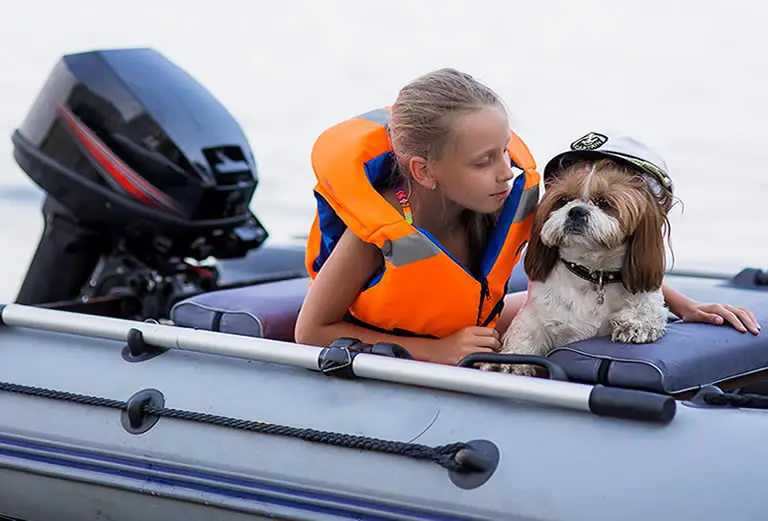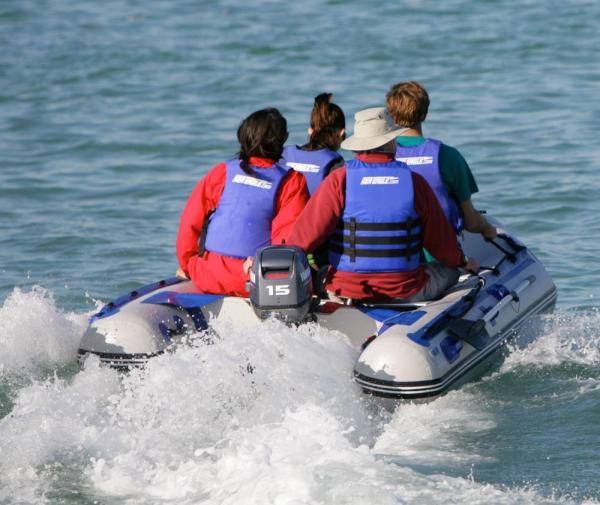In this guide, we’ll explore essential boat safety equipment and provide expert tips for passengers of all ages, including kids, seniors, and even your beloved pets.
Contents
Boat Safety Equipment You Should Never Sail Without
10 Popular Boat Safety Items
- Life jackets for all passengers
- Fire extinguisher
- Visual distress signals (e.g., flares). This electronic flare is best.
- First aid kit
- Throwable flotation device (e.g., lifebuoy)
- Navigation lights
- Sound signaling device (e.g., marine whistle or horn)
- Anchor and sufficient rope
- Boat registration and documentation (make sure it is State compliment)
- Emergency communication equipment (e.g., VHF radio or satellite phone)
There are also popular SOS kits that include many of the items listed above in one handy waterproof marine-grade bag.
10 Optional Boat Safety Equipment
- Personal locator beacon (PLB)
- EPIRB (Emergency Position Indicating Radio Beacon)
- GPS navigation system
- Radar reflector
- Boat hook
- Weather radio or app
- Marine binoculars
- Marine charts and GPS chartplotter
- Survival kit
- Emergency rations and water purification supplies
Essential Boat Safety Equipment (5 Items)
- Life Jackets Save Lives: Equip everyone onboard, regardless of age, with life jackets. Ensure they are Coast Guard-approved and fit snugly. Accidents happen unexpectedly, and a life jacket can be a lifeline.
- Fire Extinguishers and Distress Signals: Fire can spell disaster on the water. Carry a fire extinguisher and know how to use it. Additionally, stock up on visual distress signals like flares to alert nearby vessels in emergencies.
- First Aid: Be Your Own Lifesaver: Accidents happen when you least expect them. Keep a well-stocked first aid kit onboard, including basic medical supplies and any necessary medications for passengers.
- Throwable Flotation Device: A throwable flotation device, such as a lifebuoy or cushion, can be crucial in rescuing a person who falls overboard. Make sure it’s readily accessible.
- Navigation Lights: Properly functioning navigation lights are vital for night-time boating. They help other vessels see you and maintain safe distances. Regularly check and replace any malfunctioning lights.
Optional Boat Safety Equipment (5 Items)
- Personal Locator Beacon (PLB): In case of a severe emergency, a PLB can transmit your location to rescue authorities, increasing your chances of a swift response.
- GPS Navigation and Radar: These tools help you navigate accurately and avoid obstacles, especially in unfamiliar waters or adverse weather conditions.
- Marine Binoculars: Enhance your situational awareness by spotting potential hazards or other vessels from a distance.
- Marine Charts and GPS Chartplotter: Plan your route and stay on course with marine charts and a GPS chartplotter. They provide real-time positioning information and depth data.
- Emergency Rations and Water Purification: In the event of being stranded, having emergency rations and water purification supplies onboard can sustain you until help arrives.
Safety for Kids on Board
- Life Jacket Rules: Children should always wear properly fitted life jackets. Make sure they understand the importance of keeping them on at all times while on the boat.
- Educational Fun: Turn boat safety into an educational game for kids. Teach them about the boat’s safety equipment and how to use it. Encourage them to spot navigation lights and practice emergency procedures.
- Supervision: Never leave children unsupervised on the boat, especially near the water. Always designate a responsible adult to keep an eye on them.
Keeping Seniors Safe Aboard
- Mobility Aids: For older passengers, ensure they have easy access to mobility aids like handrails or a boat hook to assist with movement on the vessel.
- Comfort and Shade: Provide comfortable seating and shade to protect seniors from the sun. Dehydration and overheating can be significant concerns for older individuals.
- Medication and Health Needs: Keep necessary medications and medical supplies on board for seniors with health conditions. Be aware of any specific medical requirements they may have.
Boat Safety for Furry Friends
- Pet Life Jackets: Just as humans need life jackets, so do pets. Get a well-fitted life jacket for your furry friend to ensure they stay safe in case they fall overboard.
- Stay Hydrated: Pets can become dehydrated quickly in the sun and saltwater. Provide fresh water and a shaded area for them to cool off.
- Potty Breaks: Plan for potty breaks by bringing puppy pads or a designated pet-friendly area on the boat. Clean up after your pet to keep the boat clean and sanitary.
Conclusion
Safety should always be at the forefront of your mind when setting sail.
Equip your vessel with essential safety gear, consider optional equipment for added security, and be mindful of the specific needs of passengers of all ages, including children, seniors, and even your four-legged companions.
With these precautions in place, you can enjoy your boating adventures with confidence, knowing you’ve taken every measure to stay safe on the water.


